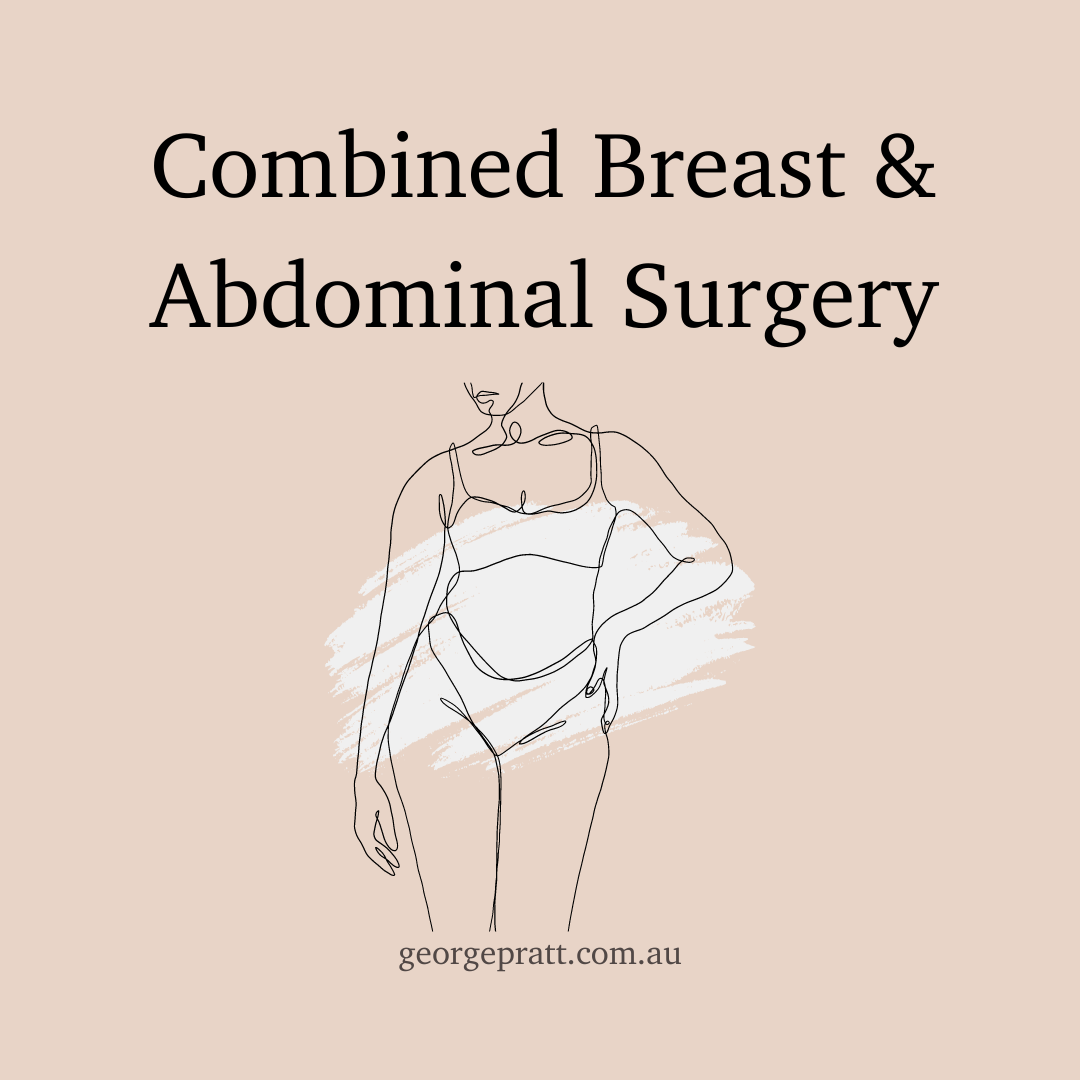Augmentation Mammoplasty
(Breast Augmentation)

While we believe in celebrating our bodies as they are, some women may have personal preferences for the appearance of their breasts and wish to change them through plastic surgery.
If you are dissatisfied with size, asymmetry, shape or volume of your breasts, breast augmentation surgery may be an option.
Dr George Pratt and his team are here to support you with their expertise and professional care that is personalised to your unique needs. Contact our friendly team or click the SEND ME THE INFO button below to download our information sheet for this procedure.
Get procedure details, price estimates and learn how Medicare and Private Health Insurance work.
What is Breast Augmentation?
Breast Augmentation (also known as Augmentation Mammoplasty) is a surgical procedure that aims to alter the size and shape of the breasts. It involves the placement of breast implants, either filled with saline solution or silicone gel, through carefully placed incisions. The implants are positioned either behind the breast tissue or beneath the chest muscle to achieve the desired outcome.
Is Breast Augmentation right for me?
Ideal candidates for breast augmentation should be in good overall health, have realistic expectations, and understand the potential risks and benefits of the procedure.
If you think you may benefit from this procedure, please schedule a consultation and Dr George will discuss your specific goals to help you determine if breast augmentation is the right choice for you.
How much does Breast Augmentation cost?
Our Breast Augmentation starts from $9,800. Please do not hesitate to book a consultation to discuss your goals and expectations with Dr George.
Note that the costs of this procedure will include the Surgeon’s fee, Anaesthetist’s fee, implants, hospital stay and post-operative care. If you have private health insurance, you maybe covered for the hospital stay. This will make your overall costs significantly lower. Please download our price guide below for a detailed explanation.
Get procedure details, price estimates and learn how Medicare and Private Health Insurance work.

Our Promise
At George Pratt Plastic Surgery, we do not believe in compromise: your wellbeing is always our top priority. We only work with the best companies and people to bring you the most personalised and highest standard of care.
If you are undergoing Breast Augmentation Surgery, we use Breast Implants by MENTOR® - one of the most popular brands with decades of research and development - which comes with a lifetime guarantee. This means that if a rupture or deflation occur, you will receive replacement breast implants at no charge.
Your surgery will take place in a fully accredited and registered hospital in Melbourne
Your surgery will be performed by Dr George Pratt, an experienced and fully qualified Plastic & Reconstructive Surgeon
Your general anaesthesia will be administered by an experienced and fully qualified anaesthetist
You will receive comprehensive post-surgery care and follow ups by Dr George Pratt himself and the team
Why Dr George Pratt?
Dr George Pratt is a Specialist Plastic and Reconstructive Surgeon with extensive experience in helping patients improve their quality of life through plastic surgery.
Fully qualified and a Fellow of the Royal Australasian College of Surgeons (FRACS), which means he has completed a minimum of 12 years medical and surgical education, including at least 5 years of specialist postgraduate training
Natural looking surgical outcome with his artistic flair and precision
Operating from the accredited world-class facilities in Melbourne
Simple and friendly consultation process
Transparent pricing and short wait times
Get procedure details, price estimates and learn how Medicare and Private Health Insurance work.
I’m ready. What is my next step?
Please ask for a referral to see Dr George Pratt, preferably from your usual general practitioner. If that is not possible, from another general practitioner or other specialist medical practitioner.
Then call our friendly receptionist, Louise, on 0385381747 or email us at reception@georgepratt.com.au to schedule a consultation. Alternatively, you can fill out the form below.
Start your journey today.
Have a question? Reach out on socials.
FAQs
-
Patients undergoing augmentation mammoplasty usually go home the same day with a surgical bra and some dressings on the wounds. We advise taking it easy for 2 weeks although some women get back to lighter work in the second week. We advise no heavy work or gym work for 4 weeks from the date of surgery.
The shape and position of the breasts continues to settle for up to 8 weeks after surgery with some persistent mild swelling not uncommon.
-
The following are so common that if you have implants in long enough you most likely will experience one or more of these. Indeed, anyone who has breast implants inserted should expect to need to have them replaced approximately every 10 years. Occasionally people will get longer than ten years’ problem-free but this would not be the average experience. If you have implants inserted when you are 20 this could mean that you need up to 5 further operations over the course of your life at your own expense.
• Capsular Contracture
Any time a foreign object is inserted into the body, a reaction occurs. The body forms a protective capsule or layer of scar tissue around the foreign material. In the case of silicone breast implants it is hoped that this capsule will always be thin and soft however this is not always the case. Occasionally over time the capsule can thicken and harden and cause pain and distortion of the breast. The only management is major surgery to remove the implant and the capsule and “start again” with a new implant.
• Implant Rupture
Modern implants are very tough. They have a thick silicone gel encased in a very tough silicone shell. However, over time the shell becomes thinner and implants can rupture. This can also be as a result of trauma- seatbelt injuries to breast implants are quite common. When an implant ruptures the gel starts to leak and the implant needs to be replaced. Often removal of the capsule (capsulectomy) will be required at the same time.
• Malposition, Malrotation
These conditions refer to the situation when an implant has moved or rotated resulting in problems with the appearance of the breast. Usually these problems require another operation to correct them. Various specific types of implant movement problems include the “double bubble” and the “waterfall” deformity.
• Animation
When an implant is placed under the pectoralis muscle, there can be a perceived movement of the implant when the arm is moved. This can be an issue for active people who do a lot of upper body gym work.
• Scars and Asymmetry
All breast surgery creates scars. Often these are discreet however after multiple operations for the complications listed above, larger incisions are sometimes required resulting in longer scars. Furthermore, whilst every effort is made to achieve symmetry in breast surgery, it is impossible to guarantee symmetry after operating on the breasts.
-
Breast implant associated anaplastic large cell lymphoma (BIA- ALCL) is a poorly understood but serious medical condition. It is a form of blood cancer (lymphoma) which is thought to be loosely related to the use of breast implants. This is a rare condition (even in women with implants) and the risk is thought to be somewhere around 1 in 50 000. Whilst we don’t know why some women develop this condition, there are some known risk factors:
• Certain type of textured implants
• Long periods between insertion of the implant and developing symptoms
• Possibly a role for infection or contamination
When identified early BIA-ALCL is usually able to be treated and cured however a small number of women have died from this condition. The risk is low however the only way to truly have no risk is to not use breast implants.
More information on BIA-ALCL can be found at https://plasticsurgery.org.au/protecting-patient-safety/bia-alcl/
-
Breast implant infection is thankfully quite uncommon. However, like with any implant in the body (joint replacements etc.) when they occur they are often very difficult to treat. Infection of a silicone implant usually will not settle until the implant is removed. It cannot usually be safely replaced until a number of months have passed. In the case of cosmetic breast implants, the hospitalisation and multiple operations to treat these problems can become very expensive.
Breast implant disease (BID)
Breast implant disease is a poorly understood condition experienced by a very small number of women after insertion of breast implants. It is characterised by many non-specific symptoms including lethargy, malaise, gastro-intestinal symptoms and non-specific aches and pains which are attributed to the presence of the breast implant. It is possible that there is a psychological component to this condition and the symptoms are often improved by removal of the implant.
Silicone Granulomas
Occasionally after many years’ silicone from breast implants can deposit in other areas of the body including the lymph nodes of the arm pit. Overall, this is not thought to be dangerous however it is essentially impossible to remove all the silicone in these situations, and the presence of enlarged lymph nodes may cause confusion and false positives when screening for breast cancer and other scans.
-
If a breast implant ruptures, the cohesive silicone gel inside the implant remains intact and doesn't pour out like a liquid. While it may cause some irritation and potentially lead to complications like capsular contracture, it is generally not a life-threatening situation. The newer cohesive silicone gel implants used nowadays have a gummy bear-like consistency, and the silicone gel typically does not travel to lymph nodes as older implant types did. It is recommended to have the ruptured implant replaced, which involves removal, cleaning, and insertion of a new implant. Overall, managing a breast implant rupture is usually manageable and not a major health concern. Dr. Pratt is available to provide support and address any further questions.
-
Yes, it is safe to fly with breast implants. Whether you have silicone or saline implants, atmospheric changes during flights do not affect them. Implants are solid and do not contain air pockets, so they do not expand or contract while flying. However, the main concern when flying after breast surgery is the risk of blood clots in the legs. It is important to discuss this with your surgeon and take necessary precautions. Simple measures like taking a prescribed low-dose aspirin, moving around during the flight, and staying hydrated can significantly reduce the risk of blood clots. It is important to follow your surgeon's guidelines for post-surgery care and recovery. If you choose to fly shortly after surgery, consult with your doctor and take necessary precautions to minimise potential risks. Flying is generally safe and should not cause any issues with your implants, but managing blood clot risks is essential for a smooth and worry-free journey.
-
Going excessively big with breast implants can lead to potential complications. These include the implant shifting to the side, bottoming out (the implant descending too low on the chest), and discomfort. It's important to prioritise your long-term well-being and consider the impact of larger implants. Optimal results in breast augmentation focus on proportionality, aiming to enhance your existing figure while maintaining a harmonious balance. Finding the perfect size that makes you feel confident and comfortable is key to achieving the desired outcome and minimising potential complications.
Most Popular
Dr George Pratt often receives enquiries about his Combined Breast & Abdominal procedures.



